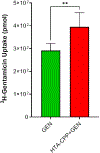Nanogels conjugated with cell-penetrating peptide as drug delivery vehicle for treating urinary tract infections
- PMID: 40024488
- PMCID: PMC12090905
- DOI: 10.1016/j.nano.2025.102812
Nanogels conjugated with cell-penetrating peptide as drug delivery vehicle for treating urinary tract infections
Abstract
Among hospital-acquired infections, Pseudomonas aeruginosa-associated urinary tract infections (UTIs) are mainly caused by indwelling urethral catheters (catheter-associated UTIs or CAUTIs) and are difficult to treat, resulting in high rates of morbidity among hospitalized patients. While antibiotics can successfully treat bacteria in the bladder lumen, they are inefficient at crossing stratified urothelium plasma membranes to kill persistent intracellular bacterial communities (IBCs). Herein, we introduce an approach to target UTI IBCs by locally delivering the antibiotic gentamicin via polymeric nanogels conjugated with a cell-penetrating peptide Cys-Gly-Lys-Arg-Lys. This novel approach delivered ~36 % more intracellular gentamicin compared to drug delivered in solution in vitro. In an acute UTI murine model, the nanogel cell-penetrating peptide drug delivery system facilitated the transport of gentamicin into the urothelium and resulted in >90 % clearance of a uropathogenic P. aeruginosa clinical strain in vivo.
Keywords: Cell penetrating peptide; Drug delivery; Nanogel; Urinary tract infection.
Copyright © 2025 The Authors. Published by Elsevier Inc. All rights reserved.
Conflict of interest statement
Declaration of competing interest No conflict of interest was reported by the authors of this paper.
Figures







References
-
- Foxman B Urinary tract infection syndromes: occurrence, recurrence, bacteriology, risk factors, and disease burden. Infectious Disease Clinics. 2014;28(1):1–13. - PubMed
-
- Ronald A The etiology of urinary tract infection: traditional and emerging pathogens. Disease-a-Month. 2003;49(2):71–82. - PubMed
-
- Foxman B Epidemiology of urinary tract infections: incidence, morbidity, and economic costs. Am J Med. 2002;113(1, Supplement 1):5–13. - PubMed
-
- Foxman B The epidemiology of urinary tract infection. Nat Rev Urol. 2010;7(12): 653–660. - PubMed
Publication types
MeSH terms
Substances
Grants and funding
LinkOut - more resources
Full Text Sources
Medical

